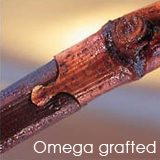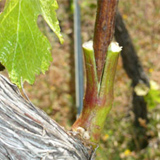Because a tiny louse called 'phylloxera', immigrated to Europe from America in the 1850's and proceeded to feast on the roots of grapevines unheeded, and to this day no cure has been found to protect vinifera vines from phylloxera. Grafting vines onto rootstocks of native American species that are resistant to the bug allows these grapevines to survive.
Miraculously, each grape variety maintains its own unique character despite the fact that its roots are foreign. The practice of grafting the fruit-bearing part of the grape vine onto the rooting part of phylloxera-resistant species continues today everywhere in the world where phylloxera is present and fine wine is made.
Grafting is a process by which two grape vine plants are combined to create an improved single vine with new desired attributes. Grape vines can also be grafted to either convert a vineyard to a grape variety that is anticipated to receive high premiums, or to remove a grape variety for which there is little to no market demand.
The two most common grafts for grape vines are combining a local bareroot with a new variety of grape vine, and combining a new vine with an old vine's established trunk. For the greatest success grafting occurs during the dormant winter season - grafting techniques include; Omega (image 2), Whip, Chip bud, T-bud, Cleft, Notch and Bark grafting. Grafting in the vineyard can take several months to complete, with the work beginning in June / July in the southern hemisphere and January / February in northern hemisphere wine regions.
The grafting of vines is also carried out because the roots of one type of grape vine might be better suited for a particular type of soil, or they might be more disease resistant than another. Or the grapes of a different variety might be favoured for making a preferred style of wine, so the grape vine is grafted onto suitable roots for a particular location or terroir.











